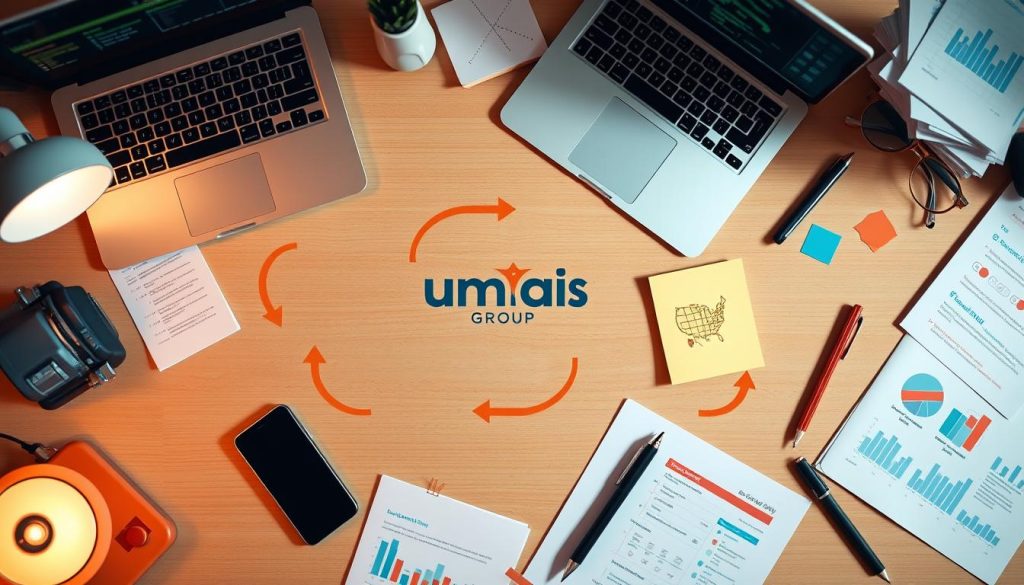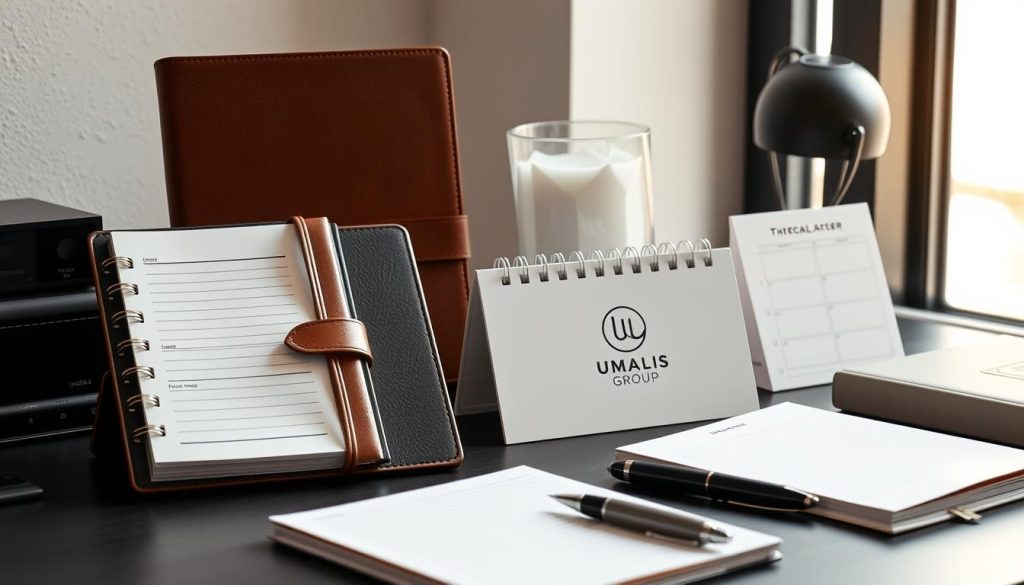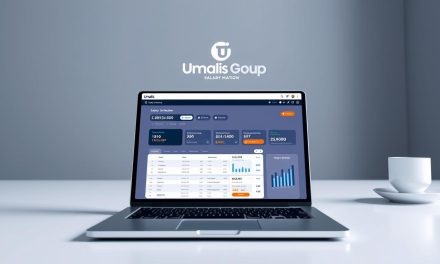Have you ever ended a workday feeling like you’ve accomplished nothing, despite racing against the clock? You’re not alone. Many professionals juggle deadlines, meetings, and personal commitments while struggling to reclaim control of their schedules. The truth is, we all share the same 1,440 minutes daily—how we organize our priorities within those limits defines our success.
Research by Dodd and Subdheim (2005) reveals a striking insight: those who master their tasks—not the clock—report 34% less stress. This isn’t about controlling hours but designing systems that align with your goals. Tools like those from Umalis’ income simulator highlight how strategic planning can transform chaotic workflows into structured progress.
This guide offers more than theory. You’ll discover methods tested by experts to boost efficiency while nurturing personal well-being. From prioritizing high-impact tasks to leveraging digital solutions, every strategy is designed to help you achieve more without burnout. Think of it as your roadmap to reclaiming both productivity and peace of mind.
Table of Contents
Key Takeaways
- Focus on organizing tasks, not the clock, to reduce stress.
- Research shows structured planning improves daily outcomes by 34%.
- Advanced tools help visualize and optimize workflow efficiency.
- Balancing professional and personal goals enhances long-term success.
- Actionable techniques adapt to various work styles and industries.
Understanding Effective Time Management
Have you ever tried to « save » minutes only to watch them slip away? True productivity starts with recognizing that hours flow forward regardless of our efforts. Effective coordination isn’t about bending the clock—it’s about aligning what matters with the reality of 86,400 seconds we all receive daily.
What Is Task Coordination?
Contrary to popular belief, you can’t control the clock. Instead, focus on organizing actions within its boundaries. Think of it as curating your commitments: identifying high-value activities while filtering out distractions. A study by Dodd and Subdheim (2005) found professionals who prioritize based on impact rather than urgency reduce stress by 34%.
Why Every Second Counts
Unlike other resources, daily hours can’t be replenished. This scarcity forces tough choices. For example, responding to an “urgent” email might feel productive, but dedicating focus to strategic projects creates lasting results. Tools like Umalis’ workflow simulator reveal how balancing short-term demands with long-term goals maximizes outcomes.
Here’s the key: distinguishing between pressing tasks and meaningful ones builds resilience. When you design systems around priorities—not chasing deadlines—you reclaim both efficiency and peace of mind.
Assessing Your Current Workflow

How often do you pause to review how your work hours truly unfold? Many professionals assume they know where their energy goes—until data reveals surprising gaps. Mapping your daily rhythm isn’t about judgment; it’s about discovering opportunities to align effort with outcomes.
Tracking Daily Activities with Time Logs
Start by documenting every task for three days. Apps like Toggl or Flamy simplify this process, automatically categorizing how you spend time. A marketing director recently discovered 27% of her day was consumed by low-priority emails—time she later redirected to client strategy sessions.
Common pitfalls? Overestimating focus periods or multitasking during complex projects. One solution: batch similar tasks. For example, reserve mornings for creative work and afternoons for meetings. This reduces mental switching costs, helping you get done what truly matters.
Identifying Productivity Patterns
Review your logs for trends. Do you tackle analytical work best before lunch? Are afternoons prone to distractions? Tools like RescueTime highlight these rhythms, showing when you use time most effectively.
Here’s a quick audit process:
- Record activities in 30-minute blocks
- Label tasks as high-impact or reactive
- Calculate your daily productivity ratio
Professionals who analyze their patterns often uncover 10-15% of their day spent on avoidable tasks. By reshaping routines around these insights, you create space for growth without extending hours.
Setting Priorities and Crafting To-Do Lists
What separates productive mornings from chaotic ones? Often, it’s the clarity of your first actions. Research shows professionals who design their to-do list before 8 AM complete 42% more high-value work by noon.
Utilizing the Urgent/Important Matrix
Stephen Covey’s framework helps filter noise from necessity. Divide tasks into four quadrants:
| Urgent & Important | Not Urgent & Important |
|---|---|
| Crisis management | Strategic planning |
| Urgent & Not Important | Not Urgent & Not Important |
| Most emails | Social media scrolling |
« The key is not to prioritize what’s on your schedule, but to schedule your priorities. »
Organizing Tasks by Priority
Start your day by tackling the “big frog” – your most critical task. This first thing morning approach builds momentum. Try this ranking system:
- 1-3: Career-changing objectives (complete before lunch)
- 4-6: Necessary maintenance tasks
- 7+: Delegate or eliminate
Refine your list each evening. A project manager reduced overtime by 19% using this method – moving client proposals to quadrant 1 while batching administrative work.
Remember: Effective lists aren’t about volume. They’re compasses guiding you through daily storms toward meaningful destinations.
Leveraging Personal Planning Tools

Professionals often drown in tool clutter without realizing how their planning method shapes daily outcomes. Choosing between digital and analog systems impacts not just organization, but your ability to protect focus from endless emails and notifications. Let’s explore how aligning tools with your cognitive style unlocks hidden productivity.
Digital Planners versus Analog Methods
Digital tools excel at automating reminders and syncing across devices. Apps like Todoist allow setting time limits for email sessions, while calendar blockers prevent meeting overlaps. However, a 2023 study found 41% of knowledge workers using paper planners reported fewer distractions during deep work phases.
| Digital Tools | Analog Methods |
|---|---|
| Instant notifications | Zero screen glare |
| Cloud backups | Tactile memory boost |
| Multi-device access | Customizable layouts |
Synchronizing Your Scheduling Tools
Hybrid systems work best for many. Try these steps:
- Color-code tasks in digital calendars and matching sticky notes
- Sync professional deadlines with personal commitments weekly
- Batch-process emails during pre-set slots using app timers
Freelancers using integrated productivity systems report 28% fewer missed deadlines. The secret? Treat tools as teammates – define their roles clearly. For instance, use paper for brainstorming and apps for tracking client communication.
Consistency matters more than complexity. Whether you choose digital precision or analog simplicity, regular use transforms these systems from mere organizers into growth accelerators.
Conquering Procrastination and Embracing the ‘Eat the Frog’ Technique
Postponing critical tasks often feels safer than facing them head-on. Yet this avoidance drains energy and amplifies stress. The solution lies in strategic action planning – transforming daunting projects into achievable steps.
Identifying Your Biggest ‘Frogs’
Your « frog » is the task you’d rather avoid – often the one with highest impact. Start each morning by asking: « Which action today would make other tasks easier? » A software developer might prioritize debugging over answering non-urgent Slack messages.
Break intimidating tasks into 25-minute segments. Research shows focused minutes yield better results than hours of scattered effort. For example:
- Draft proposal outline (25 minutes)
- Review client feedback (15 minutes)
- Schedule follow-up calls (10 minutes)
Building a Reward System for Success
Pair challenging work with meaningful incentives. After completing a frog, enjoy a fresh coffee or brief walk. This conditions your brain to associate tough tasks with positive outcomes.
Consider this approach from a Paris-based marketing director:
« Finishing quarterly reports first thing lets me enjoy client meetings stress-free. I treat myself to pastry Fridays when hitting weekly targets. »
Track things done in a visible progress chart. Visual proof of accomplishments fuels momentum. Remember: Small daily actions compound into career-defining results.
Mastering time management
Self-discipline acts as the bridge between aspirations and results. While tools and strategies matter, lasting productivity stems from cultivating inner self-regulation skills. Professionals who master this art consistently outperform peers, even with identical resources.
Building Resilience Through Structured Routines
Start by auditing daily habits. A Paris-based consultant doubled client output by reserving her first two hours for strategic work—phone silenced, email closed. This practice reduced interruptions by 40% within three weeks.
Three methods to strengthen management skills:
- Boundary blocks: Schedule 90-minute focus sessions with strict « no meeting » rules
- Progress tracking: Use simple checklists to visualize completed priorities
- Accountability pairs: Partner with colleagues to review weekly goals
Teams using structured productivity systems report 22% faster project delivery. The key lies in consistent practice—like muscle memory for your workflow.
| Disciplined Approach | Undisciplined Approach |
|---|---|
| Pre-planned deep work slots | Reactive task hopping |
| Clear priority hierarchy | Constant « urgent » firefighting |
| Weekly skill refinement | Stagnant work patterns |
Improved focus directly enhances team dynamics. When colleagues see reliable follow-through, trust grows—creating smoother collaborations and shared success.
Managing Digital Distractions and Scheduling Breaks
How many times today has a notification pulled your attention away from critical work? Modern professionals face an average of 46 daily app alerts, with social media accounting for 28% of interruptions. These disruptions fracture focus, reducing deep work capacity by 40% according to Le Monde’s 2023 workplace study.
Optimizing Email and Notification Settings
Start by silencing non-essential alerts. Tools like Slack and Outlook allow custom rules:
- Enable « Do Not Disturb » during creative work blocks
- Batch-process messages three times daily (10 AM, 1 PM, 4 PM)
- Use folder filters to prioritize client communications
| Constant Checking | Scheduled Review |
|---|---|
| 72% higher stress levels | 31% faster task completion |
| 15-minute recovery per interruption | Consistent focus periods |
Taking Effective Micro-Breaks
Strategic pauses boost cognitive performance. Try the 20-20-20 rule: every 20 minutes, look 20 feet away for 20 seconds. This reduces eye strain while maintaining workflow continuity.
« Teams using structured breaks report 19% higher accuracy in data analysis tasks. »
Three restorative tips:
- 5-minute walks after 90-minute work sprints
- Breathing exercises before meetings
- Device-free lunch hours to reset mental focus
Reduce media consumption during breaks. Professionals who avoid scrolling during pauses complete afternoon tasks 27% faster. Remember: Your attention is currency—spend it where it generates returns.
Adapting Time Strategies for Hybrid and Remote Work
Remote work blurs professional and personal spaces, challenging even seasoned professionals. A 2023 INSEE study found 63% of French hybrid workers struggle with focus shifts between home and office. Yet structured approaches can transform this flexibility into a strategic advantage.
Establishing a Consistent Routine at Home
Start by replicating office cues. A Lyon-based developer begins each thing morning with a 10-minute planning ritual—coffee in hand, desk organized. This signals « work mode, » improving task focus by 22% according to his productivity logs.
Three steps to stabilize your rhythm:
- Fixed start/end times: Protect personal hours like client meetings
- Physical workspace: Use lighting or décor to separate job zones from living areas
- Midday resets: A 20-minute walk replaces office commute transitions
Using Time Blocking for Deep Work
Parisian project managers using task time blocking complete reports 37% faster. Schedule creative work during peak energy windows—many find 9-11 AM ideal for complex job demands.
| Scattered Approach | Time-Blocked Day |
|---|---|
| Constant context switching | 90-minute focus sessions |
| Reactive messaging | Designated communication slots |
| Evening work creep | Protected personal time |
Tools matter less than consistency. Whether using Google Calendar or a paper planner, mark task time in green for visual priority. One marketing consultant improved client output by 15% simply by color-coding her thing morning blocks.
Remember: Your job success in hybrid environments depends on intentional design, not chance. Explore productivity hacks tailored for remote professionals to refine your system. As roles evolve, so should your strategies—what works today might need tweaking next quarter.
Conclusion
Transforming chaotic workdays into structured success isn’t about rigid schedules—it’s about smart systems. From prioritizing high-impact tasks to designing distraction-free routines, the strategies discussed empower professionals to make things happen without burnout. Research confirms that those who refine their approach consistently achieve 34% better outcomes.
Mastering these skills requires regular evaluation. Make sure to audit your workflow monthly, adjusting techniques like time blocking or task batching as priorities shift. Tools like the Urgent/Important Matrix aren’t one-time fixes—they’re frameworks for lifelong improvement.
Improved coordination doesn’t just boost productivity; it nurtures personal well-being. Professionals who optimize work conditions report clearer boundaries between career goals and life commitments. This balance reduces stress while amplifying long-term results.
Remember: Small, consistent changes create compounding rewards. Whether you’re tackling digital distractions or refining daily planning, progress lies in action. Every professional can cultivate these skills—start with one strategy, measure its impact, and build from there.
Your journey toward intentional work begins today. With focus and adaptability, you’ll not only achieve more but make things meaningful—both at your desk and beyond.
FAQ
How does prioritizing tasks improve productivity?
Ranking activities by urgency and importance helps you focus energy on high-impact work first. Tools like the Eisenhower Matrix visually separate critical tasks from distractions, reducing decision fatigue and increasing daily output.
What’s the best way to track daily work patterns?
Maintain a detailed activity log for 3-5 days, noting start/end times and task types. Apps like Toggl or simple spreadsheets reveal hidden time drains—like excessive email checks—and highlight your most productive hours for strategic scheduling.
Why combine digital and analog planning tools?
Hybrid systems leverage tech convenience (Google Calendar alerts) with tactile benefits (handwritten lists improving memory retention). Syncing tools like Microsoft Outlook across devices ensures deadlines stay visible while physical notebooks reduce screen fatigue.
How do "eat the frog" techniques combat procrastination?
Tackling challenging tasks first thing capitalizes on morning focus peaks. Pair this with micro-rewards—15-minute social media breaks after 90-minute work blocks—to maintain momentum through less appealing activities.
What strategies reduce digital distractions during deep work?
Schedule focused blocks with apps like Freedom to block notifications. Use email filters to prioritize urgent messages, and set « Do Not Disturb » modes on collaboration tools like Slack during critical thinking sessions.
How can remote workers maintain structure without supervision?
Establish fixed start/end times and designated workspaces. Time-blocking techniques—like dedicating mornings to client projects and afternoons to administrative tasks—create artificial deadlines that mirror office environments.
Why do professionals need scheduled breaks?
Planned 5-7 minute pauses every 90 minutes prevent cognitive overload. Techniques like the Pomodoro Method alternate focused sprints with recovery periods, sustaining energy levels while maintaining progress on complex deliverables.





